Persimmon 2.0 Instructions for use
- Tutorial
“Everything is poison, everything is medicine; both determine the dose "
Paracelsus
Surprisingly, after the publication of the article Notes phytochemist. Persimmon is my facebook LS-box just exploded from dozens of posts. For me, this was a real discovery that the "club of persimmon fans" is so great and multiethnic. One of the most frequently asked questions was "Who should not eat persimmon? How much can children eat persimmon? What kind of blockage can there be from persimmon?" etc. Gathering my strength, I wrote another article in which I tried to answer these questions in detail. In addition, if you are interested in how the "knitting taste" of persimmon is associated with fish, that they are treated with tannins and why you can not be afraid of "gastric stone" - I traditionally ask for cat.
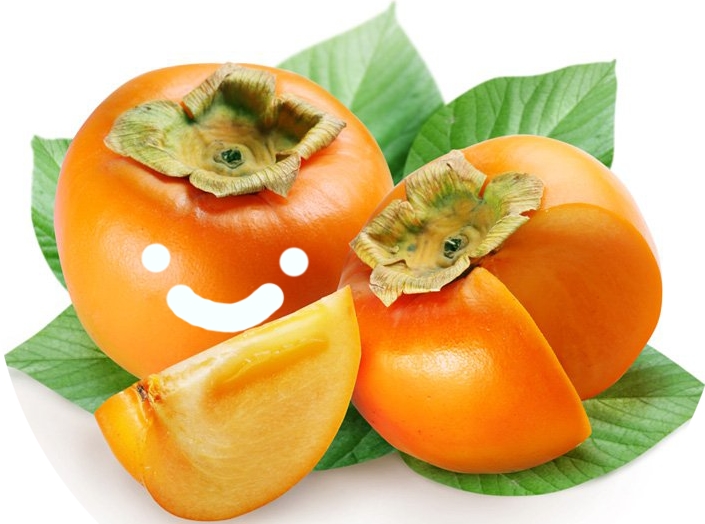
In most cases, the stumbling block in persimmon gastronomy is its astringent taste.
For captain John Smith was right in his book of 1624, The Common History of Virginia, when he wrote about an unripe persimmon, "... being collected before it is ready, he will tear off a man's mouth in immense suffering ...".

And although there are lots of ways to get rid of the knitting taste (see the end of the article), let me dwell on this phenomenon in more detail and bring some clarity.
About astringency
Speaking about persimmon, it is impossible not to say at least a couple of words about the mechanism of its "knitting action" or tartness. We feel toughness when we try unripe persimmon, drink strong tea / coffee or dry red wine. All of these components contain tannins. And the interaction of tannins with special protein compounds present in the oral cavity forms the above-mentioned taste sensations. These compounds are called mucins. They are the main component of the secretion of all mucous glands.
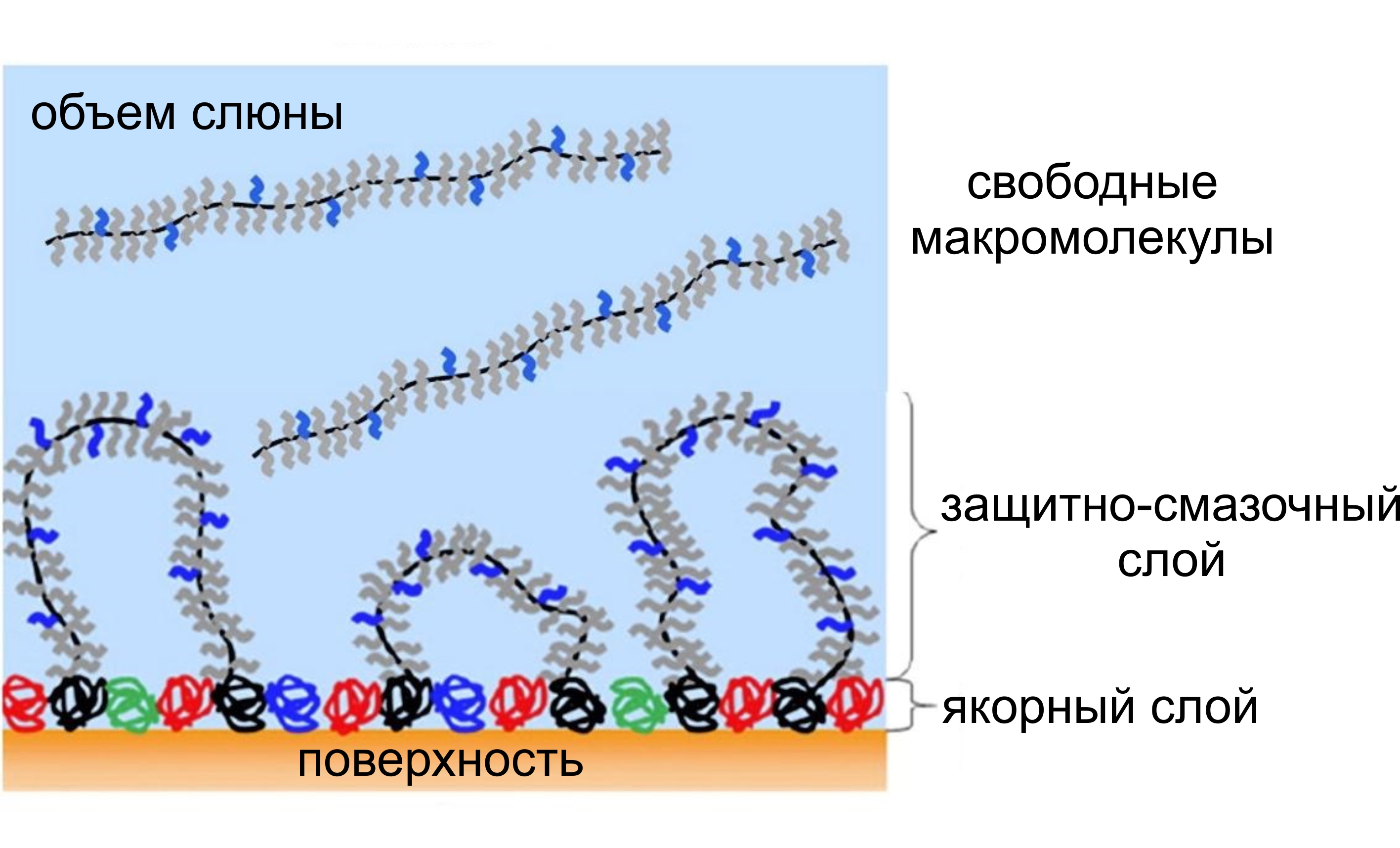
High-molecular mucin that is adsorbed on the surface serves to lubricate the boundaries of the rubbing surfaces (for example, the oral cavity and food), and the free mucin in the volume of the secretion of the salivary glands is so-called. colloidal stabilizer and regulates the viscosity and elasticity of saliva. Therefore, any food and drinks can interact with saliva proteins both on the surface and in the solution volume (due to physicochemical interactions or changes in the conformation of saliva proteins) and actively influence the composition and rheological properties of saliva.
The mucin molecule (in the saliva there are so-called mucin-1 (molecular weight 250 kDa) and mucin-2 (molecular weight 100 kDa)) is like a comb and consists of the protein part (a solid line of peptides) and short polysaccharide chains consisting from fructose, galactose, N-acetylglucosamines and other sugars. Having a gel-like consistency, these glycoproteins bind a large amount of water and provide uniform lubrication (by lowering the friction coefficient) and moistening the oral cavity. Mucins form a barrier and protect sensitive mucous membranes from drying out and chemical and mechanical effects.
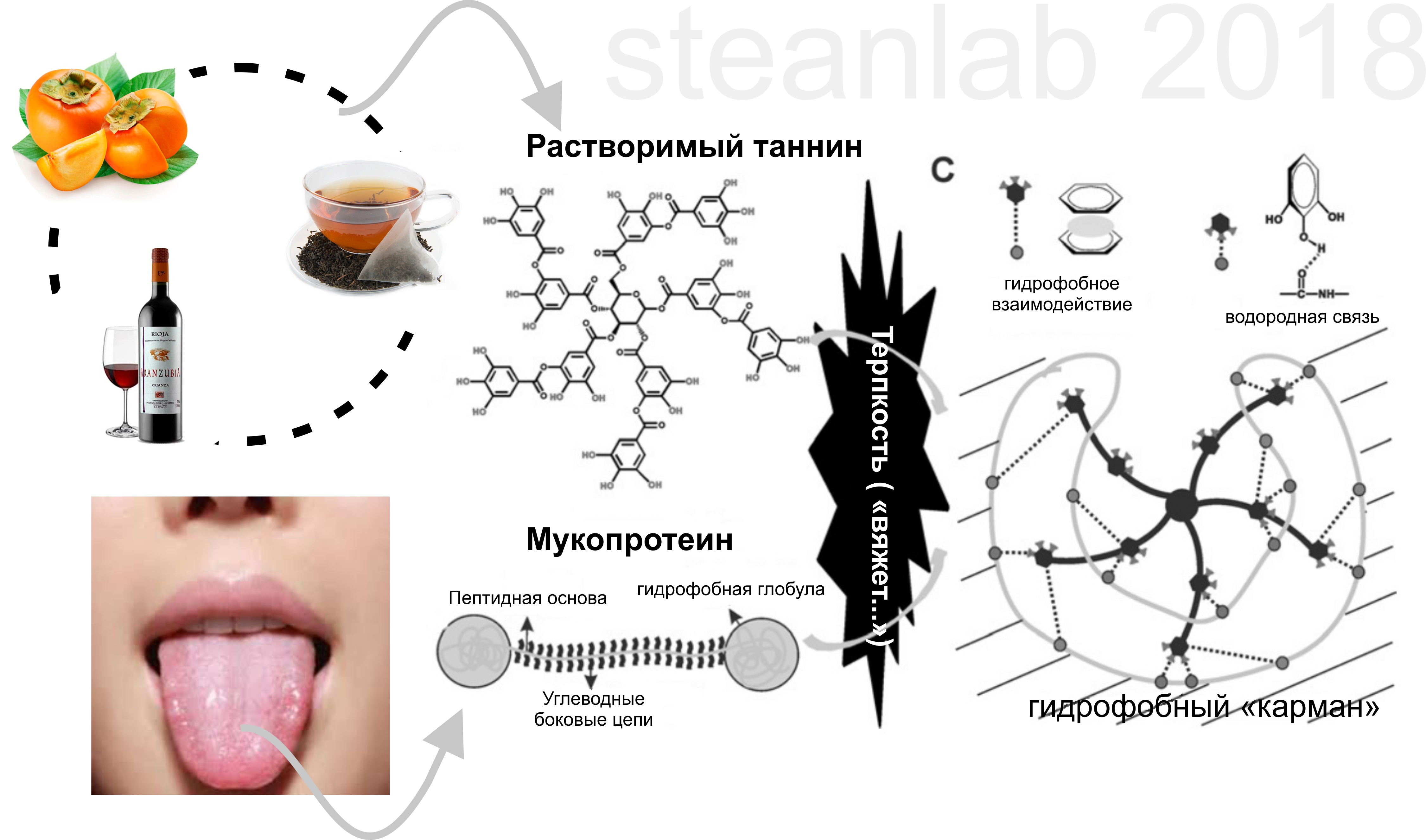
In the normal state, the surface of the tongue and mouth is covered with a uniform thin film of saliva containing mucins. Upon contact with products containing binders (tannins) components, the mucins, like any other proteins (as described above), enter into chemical interaction with tannins. Their solubility in water decreases, aggregation and even precipitation occurs. Those. after contact with tannins, the smooth, glossy surface smeared with mucin-containing saliva begins to resemble a rough sandpaper formed by a multitude of micro-tear. Those. in its simplest use, a tart taste is when the tongue becomes less slippery.
This process is described in an interesting paper.conducted by a Sino-Korean research team that created a "tongue emulator" of a mucin-containing plastic hydrogel. In the initial state, this object was elastic, with a very low coefficient of friction, and easily slid along an inclined surface. The addition of tannin solution made the hydrogel sticky, forcing the water to lose actively and shrink in volume. The mechanical strength of the "tongue" has increased significantly, the elasticity has decreased, on an inclined plane, he no longer slid. As they say, zadubel ... Researchers did not stop at the results and developed special gloves "for holding fish" (!). The slime that covers fish scales is similar in composition to saliva, which means, the researchers suggested, will also interact with tannin. Gloves were created for inspection, which separated the tannin solution on contact. The fish was caught and ... retained.

In Figure E) - a scheme for fishing with the use of "tannino-gloves", F) - the fish is fixed with the help of "tannino-gloves", G) - fishing is failed if a common glove is used.
It would seem that the idea that they are tannins are bad and harmful, the language deprives of its important qualities. And no. In fact, this is a fairly common class of compounds actively used in medicine.
Tannins of plants
In fact, tannins or tannins (tannins) are organic compounds of complex composition, so-called. polyphenols. This is how these compounds look like (for example, tannin powder):
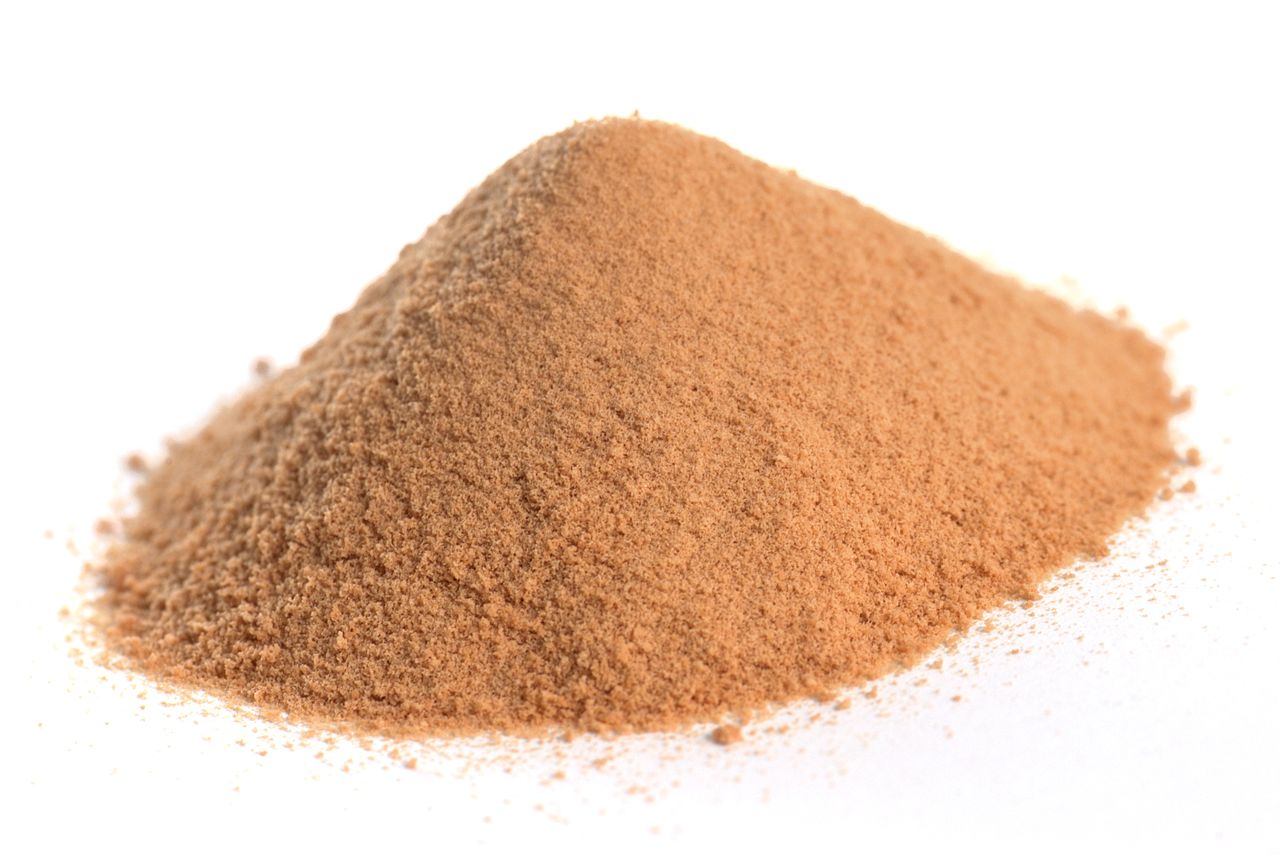
Tannins (from the Latin name of Celtic oak - "tan") are high-molecular polyphenolic compounds, the distinguishing feature of which is the ability to turn raw animal skins into a durable, waterproof and rot-resistant product - the skin. Usually, oak bark was used for this process, which later gave the name to the tanning process and the class of substances (“tannic”). For the first time the term "tannins" was introduced into circulation in 1796 by the French researcher P. Seguin. Tanning is a complex physico-chemical process of formation of a stable structure due to the appearance of hydrogen, covalent and ionic bonds between collagen molecules and phenolic groups of tannins.
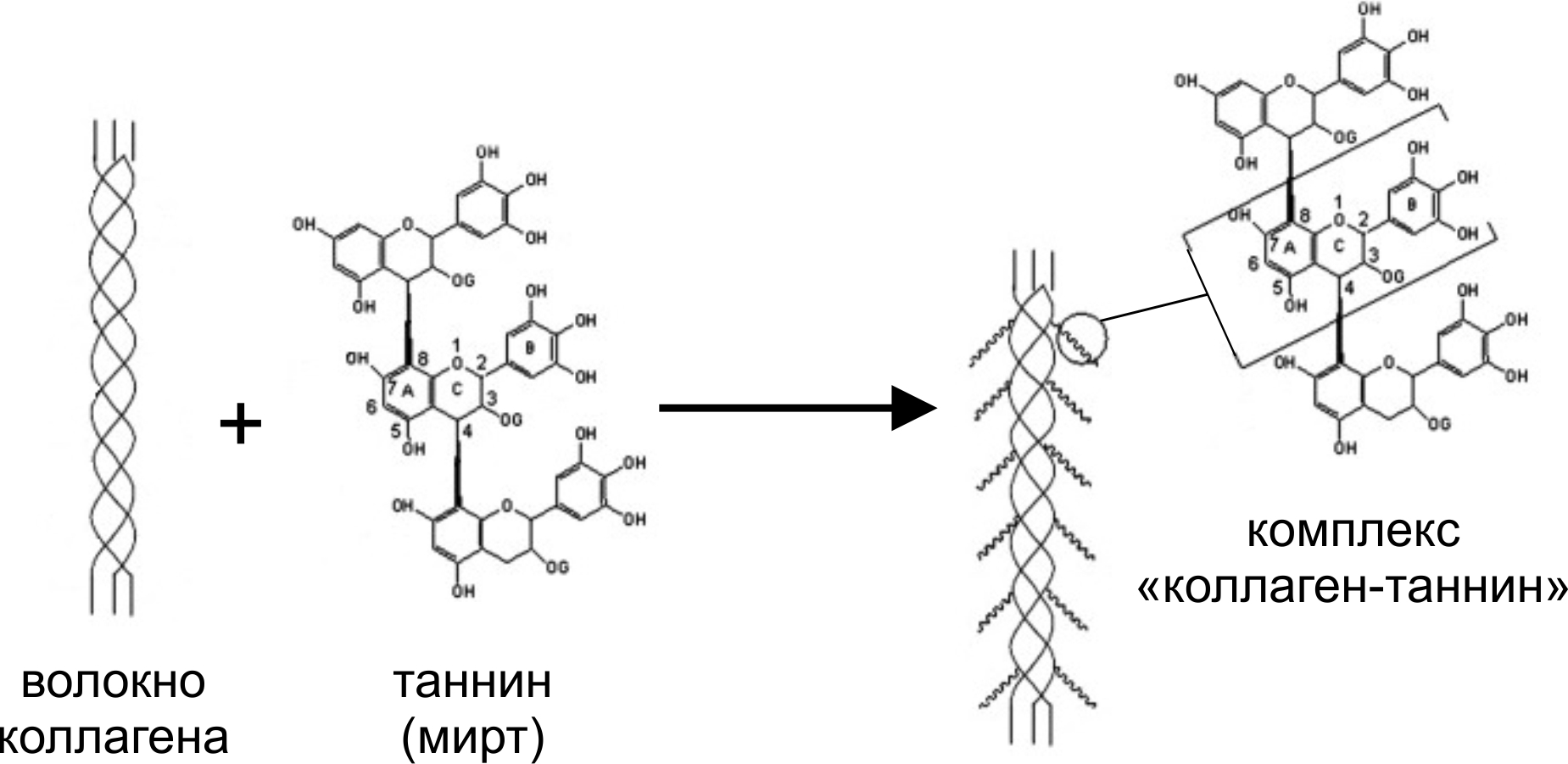
The peculiarity of the process is that tanning occurs only in the case of a sufficiently large size of tannin molecules (molecular weight 500-3000). Low-molecular compounds have an astringent taste, but are not suitable for tanning. According to the most frequently used classification by Freudberg, tannins are divided into two large groups: hydrolyzable and condensed.

Hydrolyzed tannins under the action of acid or enzymes are hydrolyzed into their constituent parts. But condensed tannins under the action of acids undergo further compaction and condensation, and the resulting red-brown condensation products are called flobaphenes .
As I already mentioned, tannin solutions bind to proteins (as well as alkaloids and heavy metal salts) to form insoluble compounds. Human skin proteins are no exception. Upon contact with protein molecules in the mucous membranes or superficial layers of the skin, tannins fix these molecules and cause them to thicken, forming a film impermeable to water. Their medical use in the form of astringents is based on this, since The film formed on the mucous membranes prevents further inflammation, and, applied to the wound, they coagulate blood and therefore act as local hemostatic agents. Best of all, tannins act as astringents.
Astringentswhen applied to mucous membranes, skin. wound surfaces cause compaction of the surface layer of the tissue (tanning effect) with a decrease in its permeability due to nonspecific physicochemical changes of colloids of cells, extracellular fluid, mucus, exudate. Interacting with proteins, they form insoluble albuminates (coagulation). Forms a dense elastic film that protects tissues from the effects of irritating substances, reduces pain, contributes to the narrowing of the capillaries, reducing hyperemia, compaction of the vascular wall, reducing the secretion of glands and enzyme activity. Reducing tissue permeability blocks exudation. Reducing the activity of enzymes, drugs extinguish the "fire exchange" in the inflammation. The combination of these effects explains the local anti-inflammatory effect of astringents. Coagulating plasma proteins, they help to stop the capillary bleeding. Coagulation of microbial cell proteins provides antimicrobial action.
Externally used to stop small capillary bleeding on the skin, to treat minor burns, such as sunburn, to treat wounds and frostbite (due to the tanning effect). No wonder in the first part of the story about persimmon I mentioned that Koreans treat her for burns and wounds. Actual, the same was used on our latitude, but instead of persimmon they used more accessible oak bark. Inside tannins are used to slow down the strong motility of the gastrointestinal tract resulting from indigestion ( Important! But for people prone to constipation, the situation will only get worse!), for rinsing the mouth, in the presence of inflammation in the mouth or gums (bleeding), throat with sore throats, for washing the stomach in case of diarrhea, against inflammation formed on the mucous membranes of the intestine and stomach. Due to the ability to form insoluble compounds with glycosides, alkaloids and heavy metal salts, tannins are used as antidotes. Hydrolyzed and condensed tannins exhibit high P-vitamin activity and anti-sclerotic effect, which is why doctors often recommend persimmon to those who suffer from varicose veins.
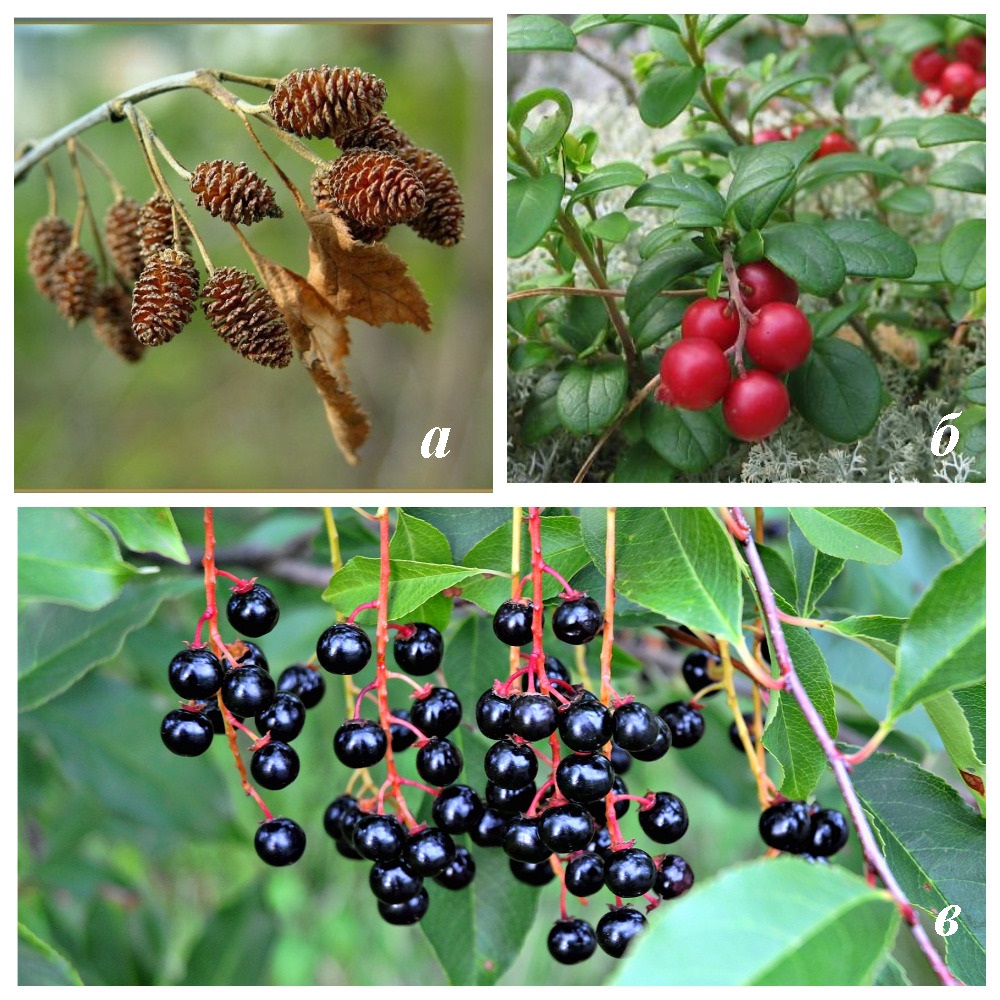
Some of the strongest tannins in our latitude are: a - alder, b - lingonberry, c - bird cherry.
The following herbal preparations can be cited as examples: the Tannin preparation , obtained from the leaves of skumpii tanning and the leaves of sumach tanning leaves, has an astringent, anti-inflammatory and antiseptic effect. It is used in the form of solutions (for washing the stomach for poisoning), lotions for burns, rinses, ointments. Altan and Camilal preparations with antimicrobial, anti-edematous activity and local hemostatic effect are obtained from the alder seedlings . Oak bark and cherry fruit are actively used as an individual astringent and anti-inflammatory agent. Fruits / leaves of bilberry and lingonberry used in the form of drugs Arfazetin , Mirfazinpossessing hypoglycemic action. Strong black tea has anti-inflammatory action, is used as an antidote for alkaloids poisoning.
Stone in the stomach
The most common horror story of opponents of persimmon is the argument "a stone is formed in the stomach." Well, let's go about the stone to dot the i's, especially since the tannins, the participation of which is here, we have already considered. In general, this is how this very stone describes Wikipedia:
Bezoar, bezoar stone (Pers. بازهر bâzahr "padzahra" - translated as "antidote") - a foreign body in the stomach, dense calculus formed in the gastrointestinal tract when swallowing certain substances of natural or synthetic origin

Bezoars have been known since ancient times and were previously highly valued for their properties, since they were thought to possess the power of a universal antidote to any poison. Most often concrements were found in mountain goats, in whose stomachs they were represented as grayish-blue dense formations of wool, mucus and leaves. This animal (in the picture) even got its name from the name of the stone - bezoar goat.
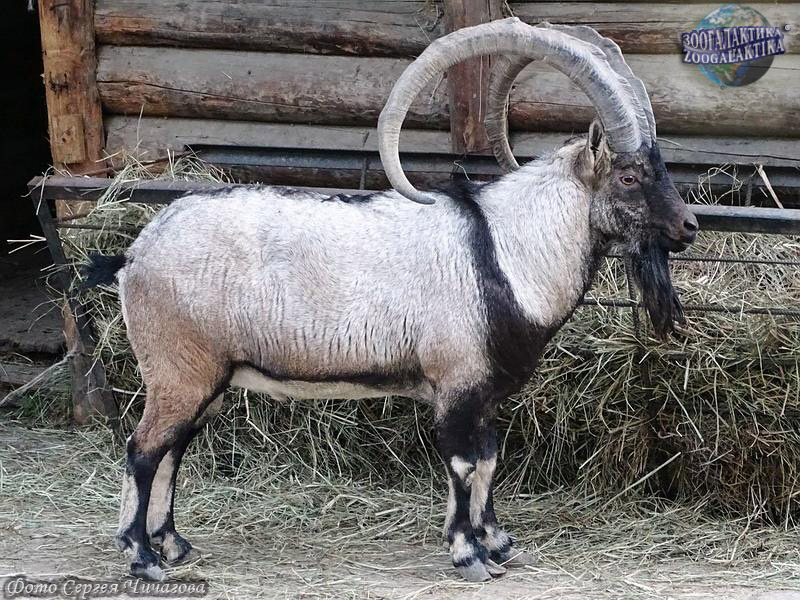
It is believed that bezoar goats are one of the ancestors of modern domestic goats.
Surprisingly, even today (in the world of CRISPR and monoclonal antibodies), people who believe in miracles still remain, and bezoars are quite expensive on the black market. Therefore, the species continues to be under threat due to poachers.
Even more surprising are the real modern prices for the so-called. gall bezoara animals. Especially in China, traditionally living in its own world of alternative medicine.
Bezoars occur mainly in ruminants. In humans, bezoars are relatively rare. In the national gastroenterology, the first mentions of pathology are found at the beginning of the 19th century in the works of the Russian surgeon V.M. Mouse. Gastric stones are rare, in the early 1990s. about 400 cases of the disease have been described.
There is also a pseudo - besoar - some indigestible object that is intentionally introduced into the digestive system for medical purposes (for restoring the volume of the stomach, for example).
Bezoars may have different composition and consistency (loose, dense, firm, elastic). Depending on the type of constituent components, the calculus can be both organic and inorganic. The most common are phytobezoars. They make up to 70% of all bezoars. Formed by eating peels, seeds, rinds of berries and fruits (persimmon, cherry-cherry, hawthorn, grapes, figs, etc.). Vegetable substances (undigested lignin, cellulose, tannins celery, pumpkin peel, grape skin, prunes, raisins, other vegetables and fruits) are gradually overgrown with mucus, fat and mineralized. Concrements have a different consistency, fetid odor, dark green or brown color. There are other varieties - see under the spoiler.
Трихобезоары (пилобезоары). Занимают второе место по частоте. Они представляю собой войлокообразные комки волос с примесями слизи и частичками пищи и образуются при регулярном попадании волос в желудок. Встречаются такие безоары у детей с шизофренией, которые страдают от трихотилломании – навязчивого выдергивания волос. Кроме того, они обнаруживаются у людей с нарушенной психикой, которые кусают свои волосы и профессионалов, занимающихся обработкой волос ( парикмахеров).

От такую "мягкую игрушку" извлекли из молодой девушки, жившей с привычкой постоянно покусывать волосы...
Стибобезоары. Формируются при частом употреблении жирных продуктов животного происхождения (козьего, бараньего и говяжьего сала без термической обработки). Попадая в желудок, пища трансформируется, уплотняется и формирует жировые конкременты.
Шеллакобезоары. Возникают при использовании в пищу несъедобных продуктов химического происхождения (нитролак, клей БФ и политура алкоголиками, краска). При поступлении в желудок вещества взаимодействуют с водой, выпадают в осадок. Шеллачные камни имеют вязкую консистенцию, слегка шероховатую поверхность, темно-коричневый цвет.
Лактобезоары. Формируются у новорожденных детей, кормление которых осуществляется искусственной смесью с высоким содержанием лактозы и казеина. К образованию конкрементов склонны недоношенные дети.
Упомянуты в научной литературе и другие типы безоаров, которые встречаются в единичных случаях. Пиксобезоары – употребление либо проглатывание жевательной резинки и пластилина детьми, попадание в желудок смолы или вара. Гемобезоары образуются при продолжительном заглатывании крови у больных с носовым и пищеводным кровотечением при портальной гипертензии и красной волчанке.Фармакобезоары могут возникать при приеме труднорастворимых и нерастворимых лекарственных средств (гидроксид алюминия, активированный уголь и т.п.). Миксобезоары состоят из ниток, шерсти, кусочков древесины.
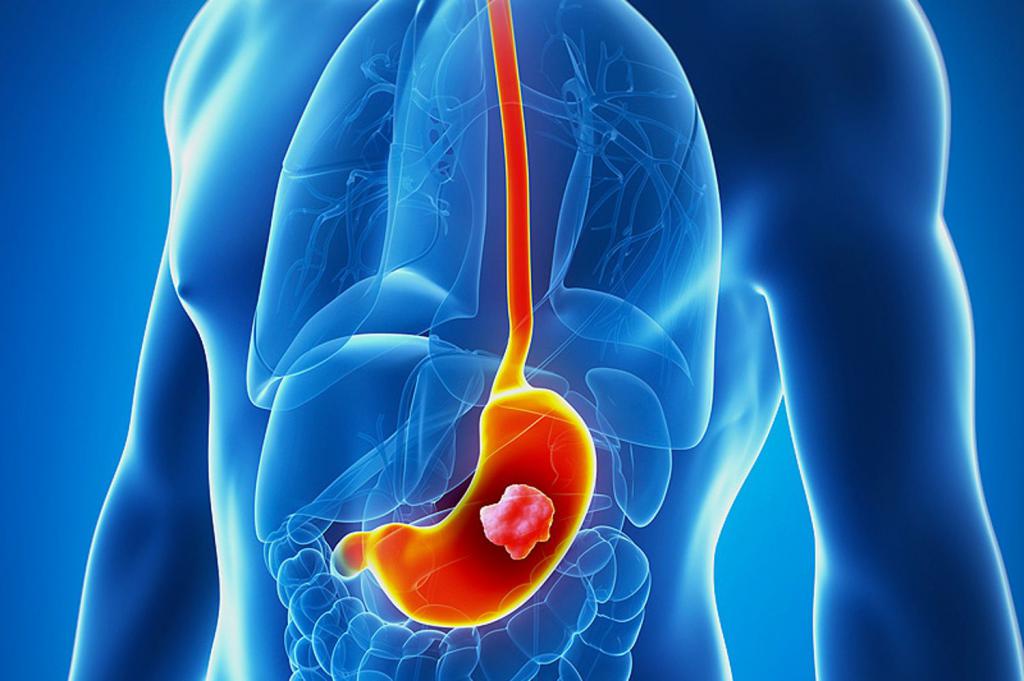
Predisposing factors of phytobezoaces are:
- Disruption of food culture. Poor chewing of coarse-fiber heavy food (+ problems with teeth), swallowing fruit pits
- Insufficient excretion of hydrochloric acid, slow evacuation of the contents into the duodenum due to gastroenterological pathology and impaired gastric motility ( gastroparesis , secretory insufficiency, diabetes and hypothyroidism and related decreased motility)
- Excess reproduction of fungi of the genus Candida ( candidiasis ) in the stomach initiates the formation of fungal bezoars .;
- Surgery on the stomach. Transferred surgical interventions (resection of the stomach, vagotomy) contribute to the reduction of secretory function, impaired digestion, the accumulation of hard-to-digest products
- High viscosity of mucus in the composition of the gastric juice (may occur when taking some anti-ulcer drugs)
Not surprisingly, phytobezoars can be formed after eating persimmon and pineapple. This type of calculus is called diospirobezoarami . Clinical manifestations in our latitudes are rare (for we have a persimmon only for the New Year), but in countries where persimmon is grown, it is found quite often. The formation of phytobezoars from persimmon is due to a chemical reaction between the hydrochloric acid of the stomach and flobatannin (see “Tannins of plants”) contained in persimmon. An important role is played in this and tannin persimmon (note my - "Hurmatannin"), with a maximum content in the peel of immature persimmon. The substance was first isolated and studied by Japanese chemists S. Komatsu and N. Matsunamiback in 1923. The Japanese isolated phenolic compounds from the juice of immature persimmon and called them shibuol ( shibuol ). Until 1961, its structure was unknown, and accordingly their mechanism of chemical interaction was unclear. In 1961, using the analysis of methanol extracts, it was found that the main component of "hurmatanin" is the substance leukodelphinidin (5,7,3 ', 4', 5'-pentahydroxy-flavan-3,4-diol) -glucoside. The formula for this wonderful substance is below:
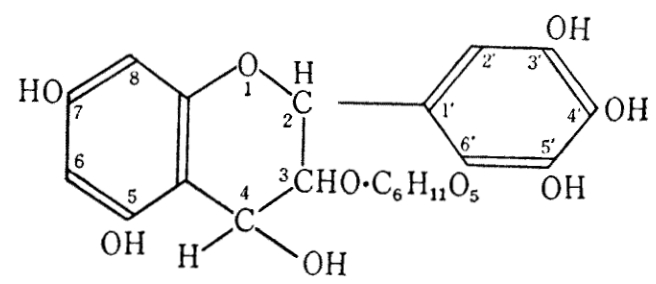
The loss of astringency during the ripening of persimmon or in the case of various methods of converting persimmon fruit binders into sweet ones is interpreted as a decrease in soluble shibuol due to molecular condensation. At one time, the Japanese conducted an experiment by adding hydrochloric acid to a suspension of persimmon peel. The coagulum obtained was very loose and did not closely resemble a human bezoar. In this way it was found that the transformation of soluble Shibuol into insoluble is a necessary, but not sufficient condition for the formation of a stone. Some high molecular weight binding agent + mechanical effect on the stomach must also be present.

Stages of obtaining a synthetic gastric stone: 1 - a suspension of persimmon before processing,
2,3 - Early stages of rotation after adding hydrochloric acid and flocculant, 4 - After 2 hours of rotation of the system.
When the authors took a suspension of persimmon, hydrochloric acid and high-molecular flocculant were added there ( KONANFLOC ZH-760, an aromatic polyamide ~ nylon) and additionally subjected to slow rotation to simulate active gastric motility, the resultant was synthetically obtained bezoar, quite like a human. It remained to find a source of high-molecular compounds (nylon in the stomach, to put it mildly, a rather rare guest). Here it was assumed that gastric juice and saliva contain a significant amount of viscous substances, in the role of which mucin-1 and mucin-2 mentioned above can be used (see “On Tolerance”). In addition, the rind of persimmon also contains high-molecular compounds that can act as coagulants. The researchers found that the suspension of persimmon in distilled water, without the addition of hydrochloric acid or flocculant showed clearly visible coagulation. In addition, soluble persimmon schibouol precipitates proteins and starch quite well, and insoluble actively adsorbs them. In turn, the Shibuol-protein and Shibuol-starch complexes later also participate in the adhesion of persimmon slices. Those. For the formation of calculus necessarily need a significant amount of high molecular weight organic substances. A mechanism has been proposed as follows:
- When using the immature fruits of persimmon or persimmon knitting varieties, in the stomach, under the action of inorganic and organic electrolytes, a loose coagulate is formed, consisting of fragmented pieces of persimmon. The sources of electrolytes are the persimmon itself and the food that is taken simultaneously with it, as well as gastric juice and saliva.
- Insoluble schibuol, precipitated with hydrochloric acid, various complexes of schibuol (due to adsorption) and other high-molecular compounds, accelerates the coagulation of the suspended persimmon pieces, acting as a kind of binder
- The coagulum becomes dense and gradually dehydrated. Compaction occurs due to kinetic energy, which is released as a result of contraction of the stomach walls and body oscillations in the process of human movement.
And already the traditional " how to be saved ." Fitobesoar, in contrast to, for example, trichobezoar for which only surgical treatment is indicated ("indigestible" hair keratin is resistant to most of the available proteolytic enzymes), it can be completely destroyed without unpleasant operations. Traditionally, the gastric stone is identified with the help of an endoscope, and small calculi are attempted to be mechanically extracted with the help of special baskets or traps . If the stone is large enough, it is pre- crushed into small pieces (like kidney stones or in the gallbladder) using mechanical / electrohydraulic lithotripsy, or using a solid-state Nd: YAG laser (yttrium aluminum garnet (YAG, Y3 Al 5 O 12 ) doped with neodymium ions (Nd) with a wavelength of 1064 nm). Also to reduce the size of using chemical exposure to enzymes of the group of cellulases (catalyzing the hydrolysis of cellulose with the formation of glucose) or papain.
Papain (lat. Papain) is a polypeptide, a proteolytic plant enzyme that catalyzes the hydrolysis of proteins, peptides, amides and esters of basic amino acids. In significant quantities contained in the fruits of the melon tree - papaya
The review shows that, for example, in approximately 50% of cases, Coca-Cola alone managed to dissolve the phytobezoar, in the case of a combination of a drink with other methods described above, the efficiency reached 90%. Interestingly, the most common "harmful" Coca-Cola is best suited for dissolving diospirobezoara . Moreover, it works much better than digestive enzymes, like papain and the "useful" Coca-Cola Zero. Why is this happening - it is not clear, the question is waiting for itsbiochemists researchers ...

Well, and only in exceptional cases (a very large calculus, or very old and mineralized), when non-invasive methods turned out to be ineffective - you have to operate and get the stone by hand.
Summing up and distribution of elephants
What is the conclusion of all written? And the conclusion is the same - the persimmon is necessary, because all its flaws occupy a scanty part of the merits.
"Terrible and dangerous" tannins, they are tannins, contained in a huge amount of fruits and berries (much less in vegetables).
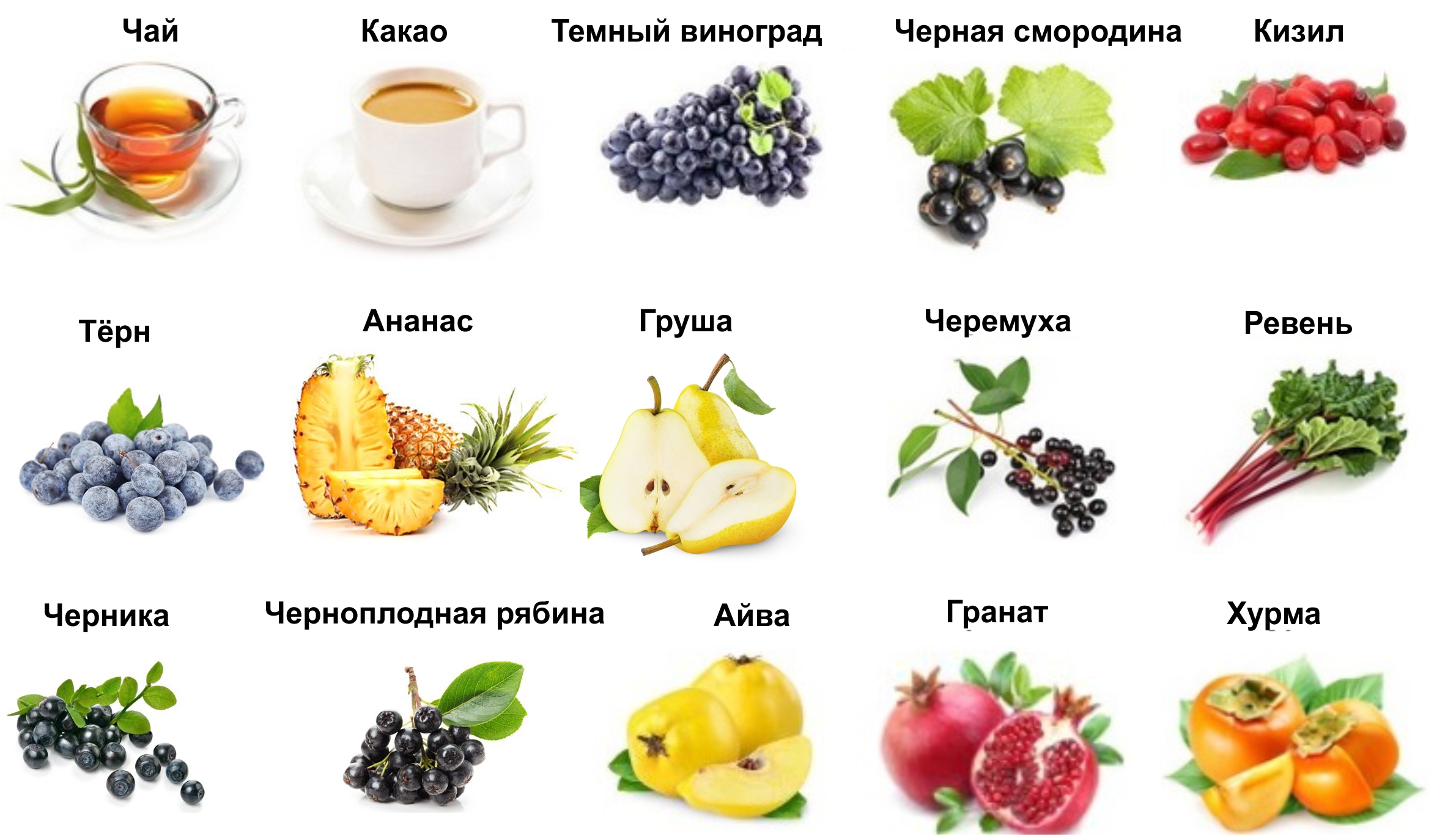
Blueberries, blackberries, strawberries, raspberries, lingonberries, cherries, pineapple, lemon, orange, grapefruit, mango, kiwi, nectarine, peaches, pear, apricot, plum, banana, avocado and pomegranate - and this is not a complete list. According to the Journal of Nutrition (aka widely known in narrow circles as an academic “Nutrition Journal”), the same "native" apples are the main source of tannins in the body. I will not repeat their useful properties once again (because I also wrote in phytochemists. Persimmon and in the “Tannins in Plants” section of this article). For fans of additional reading, I can recommend the article Tannins: Current knowledge of food sources, intake, bioavailability and biological effects in the journalMolecular Nutrition and Food Research ( Molecular Nutrition and Food Research ).
As mentioned in the section devoted to the formation of phytobezoars, the prerequisite for the formation of calculus is the presence of a) tannins as an adhesive / sorbent b) high molecular weight fillers (cellulose, lignin, etc.). Offhand, you can even say that pineapple and pear (sources of tannins + coarse fiber) may have an approximately comparable potential to persimmon formation of gastric calculus. But I have never heard from someone that "do not eat a lot of pears - a stone forms and clog the stomach", but about persimmon - I hear it often (especially after the first article of my article). So, I recommend to take note;)And in general, since the persimmon in our region is a seasonal fruit, it is much more likely to get a gastric stone from hair, chewing gum, or a good lamb pilaf (tricho-, shellaco- or stibbezooar).
Notwithstanding the above, “God protects you”, so you definitely need to try to choose the least astringent persimmon (if you are going to eat it and not apply it to sunburn or skin scratches, see the opposite, you need the most immature, see “Tannins in plants ").
Folk life hackingThere are many ways to reduce astringency: freezing in the fridge, and ripening on the windowsill, and aging in a bag of apples / bananas / potatoes (as with "sources of ethylene"). You can even make a "knight's move" and associate tannins before entering the stomach by preparing, for example, macedonia fruit salad with some kind of papaya (and papain in it), where alkaloids / proteins / tannins will bind to each other in a harmless and tasty mass. You can try and so-called. Egyptian with goat cheese, casein perfectly associated with tannin ...
By the way, in the eternal dispute "to remove the skin from persimmon / not to remove the skin" the adherents to "remove" still triumph if it is about reducing the amount of tannins (another thing is that this persimmon also loses many useful substances). By the way, since I’m talking about peeling, I just can’t help but mention such a thing as the Japanese sweetness Hoshigi ( hoshigaki ). The Chinese make dried persimmon, and the Japanese - Hoshig. The piece is incredibly tasty and with a minimum of tannins (this sweetness illustrates the importance of the absence of the skin, since it uses the variety “Khatia”, the most tannin-containing, among many varieties). Under the spoiler - a brief introduction to the technology:
Японцы знают толк и в приготовлении обезвоженной хурмы. И подходят к этому с присущим им национальным колоритом, прям как к заточке лезвия катаны. Первым делом японские фермеры собирают хурму стараясь не повредить плодоножку (!). Затем с хурмы снимаю кожицу (максимально аккуратно, чтобы не повредить хвостик). Слишком острый нож не годится потому, что режет слишком глубоко, слишком тупой нож не годится, потому что мнёт мякоть.
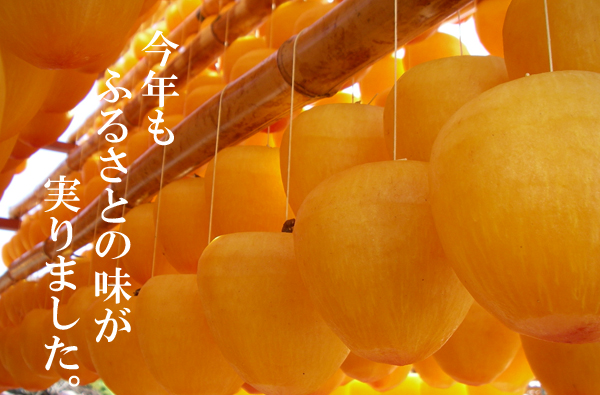
Чтобы сделать хосигаки идеально нужен японский опыт, этому искусству в Японии более 360 лет (не удивительно, потому что у японцев два любимых сезонных растения, весной — сакура, осенью — хурма). Затем оголенный фрукт омывается в бадье с японской водкой сётю "для стерилизации", обвязывается за веточку грубой хлопковой верёвкой и вывешивается для сушки там, где много солнца и свежего воздуха, но нет дождя.
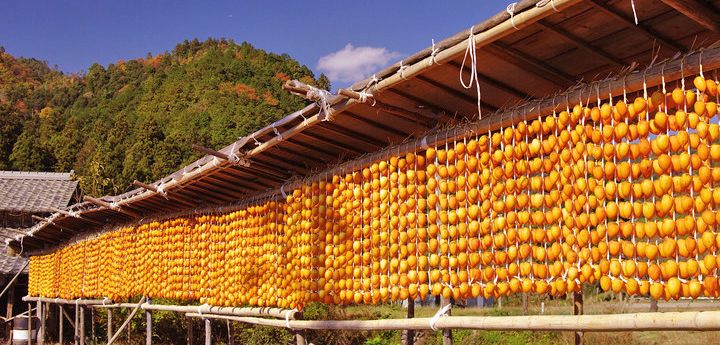
Где-то через неделю хурма начинает съёживаться. И тогда начинается самый важный этап, ежедневное подавливание ("прожмякивание") хурмы, без которого она просто засохнет, но не даст жидкой карамельной внутренности. И так от четырёх до шести недель. Когда хурма покроется белоснежной корочкой выступившего сахара — хосигаки почти готовы.
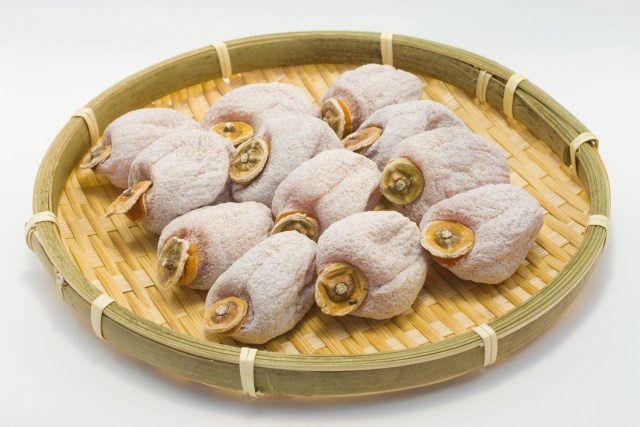
В завершение сухофрукт укладывают на мягкую подстилку из рисовой соломы свежего урожая. Рис впитывает влагу и не даёт фрукту загнить.
И хотя в Китае пытаются делать что-то подобное, и даже используют труд женщин для снятия кожицы на неком подобии токарного станка:

Но все равно, получается у них обычная сушеная хурма, а не ХОСИГАКИ...

О таком хайку не напишешь, и картинку на бамбуковом холсте не нарисуешь ...
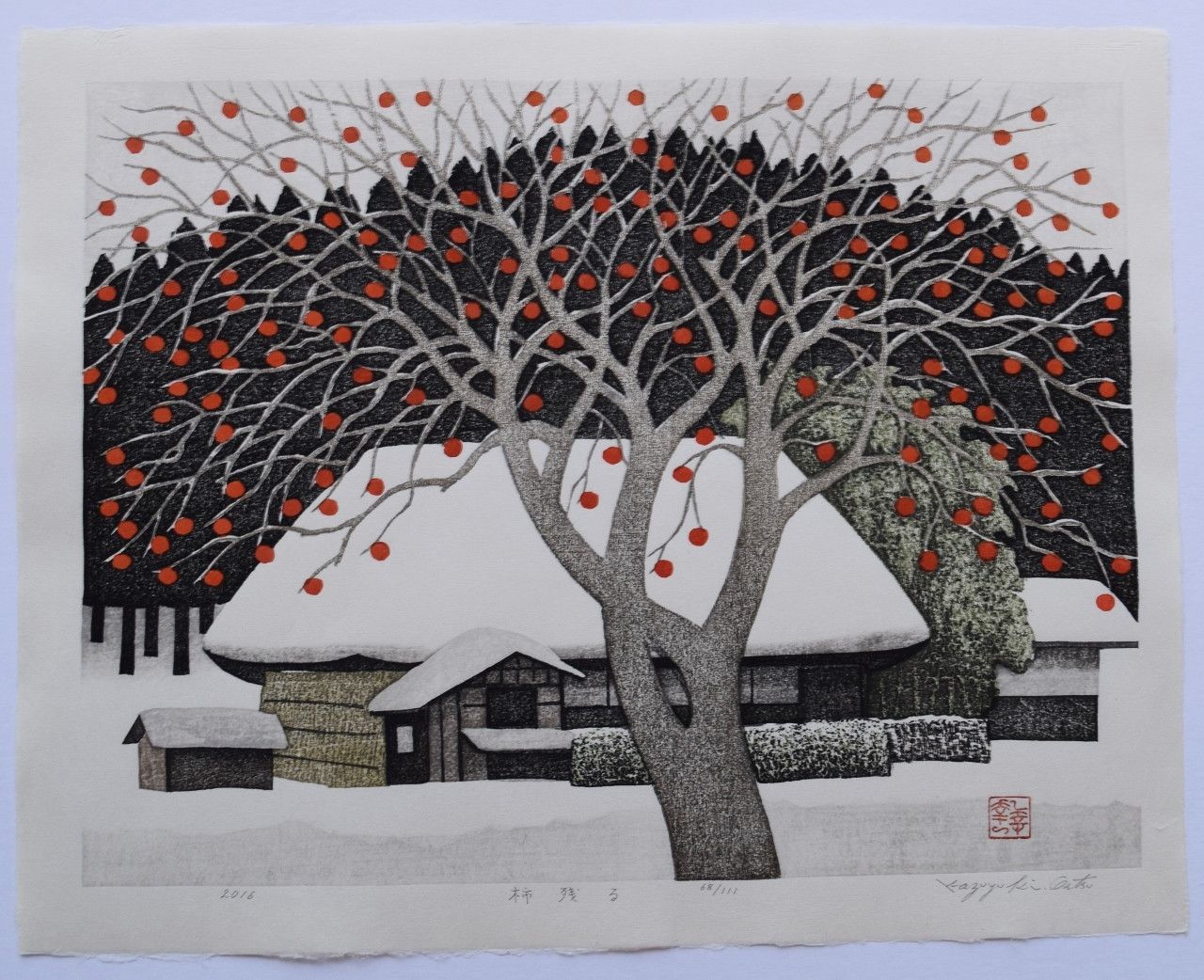
Старая деревушка.
Ветки усеяны красной хурмой
Возле каждого дома.
Мацуо Басё
Хурму откусил –
Зазвонил колокол
Храма Хорюдзи
Масаока Сики
Целая роща
Китайских фонариков
Светится ярко.
Солнца нектаром полна,
Хурма делится мёдом.
Неизвестно Кто (но мне понравилось...)
If for a perfectly healthy person, all the recommendations described above are only recommendations, as the body can easily cope with a kilogram of persimmon (one and a half - the absolute maximum ) (it is not known, however, how many times), then for people with chronic diseases there are quite objective limitations (some of them have already been mentioned as factors promoting the formation of bezoars).
The first thing to "risk group" are small children. I think many parents are familiar with such a concept as "constipation" and "colic" and imagine how many problems these diseases bear. Therefore, with great care, feed this product to children under 10 years of age. The persimmon may act unpredictably on the immature intestinal tract of a child. Plus, there is also such a thing as food allergy / intolerance. Therefore, if you really can not refuse - at least limit yourself to a small slice. Pregnant women can also follow the same recommendation (mainly due to the likelihood of an allergic reaction).
Secondly, caution should be used with persimmon for people who have undergone bowel surgery, as tannins, because of their properties, can lead to the formation of adhesions ("bridges" of connective tissue) and, as a result, to acute intestinal obstruction. Therefore, persimmon is forbidden to eat persimmon in the postoperative period (the intestinal activity of the intestine decreases -> adhesions) and people, due to the peculiarities of the gastrointestinal tract, prone to constipation.
Third, allergies. Despite the fact that, as a rule, a person knows the food allergens characteristic of him and tries to avoid them, there are different situations. Better just in case to double-check. Allergen persimmon is known in the world under the code F301 Persimmon and stimulates the body to intensive production of class E immunoglobulins (total IgE). According to this indicator, the assessment is carried out (lgE IU / ml concentration: <0.1 no reactivity or indefinite level; 0.1-0.34 reactivity is very low; 0.35-0.69 reactivity is low; 0.7-3, 49 moderate reactivity; 3.5-17.49 high reactivity;> = 17.5 (very high reactivity). You can calmly eat if the reactivity is <"low", with caution - if "moderate", in all other cases it is better not to risk it.
And fourth. Persimmon is not recommended for insulin-dependent people (type I diabetes). People with type II diabetes (with mild, moderate severity) should eat persimmon with caution. This is due both to the previously mentioned decrease in motility of the gastrointestinal tract, recorded in diabetes, and the fact that the fruit contains a considerable amount of sugar. Focus on the fact that the optimal amount of persimmon, which can be eaten at a time = 1 XE ( bread unit ). In the case of persimmon, this is about 50-70 grams, depending on the variety and degree of bedding.
For everyone else - there are no special restrictions, just "listen to your body." The moral of this “fairy tale” is that it is much more effective to eat one persimmon throughout the week than to eat seven pieces at a time.
Sergey Besarab ( Siarhei V. Besarab )
- S. Komatsu и N. Matsunami, Mern. Cqlf. Sci. Kyoto Univ., Ser. A 7, 15 (1923)
- Tohoku J. Experimental Formation of Persimmon-bezoar, Exp. Med., 1965, 86, 168-177
- Smith, John. «The Generall Historie of Virginia, New-England, and the Summer Isles». The Heath Anthology of American Literature. Ed. Paul Lauter. 6th Edition. Boston: Houghton Mifflin Harcourt Publishing Company, 2009 [1624]
- Ladas, S. D.; Kamberoglou, D.; Karamanolis, G.; Vlachogiannakos, J.; Zouboulis-Vafiadis, I. (2013). «Systematic review: Coca-Cola can effectively dissolve gastric phytobezoars as a first-line treatment». Alimentary Pharmacology & Therapeutics. 37 (2): 169–173
- Iwamuro M.; Okada H.; Matsueda K.; Inaba T.; Kusumoto C.; Imagawa A.; Yamamoto K. (2015). «Review of the diagnosis and management of gastrointestinal bezoars». World Journal of Gastrointestinal Endoscopy. 7 (4): 336–345
- Christos Plataras; Nektarios Sardianos; Stephanos Vlatakis;Konstantinos Nikas (2014). «An unusual cause of small bowel obstruction in children: lentil soup bezoar». BMJ Case Rep. 2014; 2014: bcr2013203316
- Chisholm, E. M.; Leong, H. T.; Chung, S. C.; Li, A. K. (1992). «Phytobezoar: An uncommon cause of small bowel obstruction». Annals of the Royal College of Surgeons of England. 74 (5): 342–344
- Zhang, R. L.; Yang, Z. L.; Fan, B. G. (2008). «Huge gastric disopyrobezoar: A case report and review of literatures». World Journal of Gastroenterology. 14 (1): 152–154.
- Tannins: Current knowledge of food sources, intake, bioavailability and biological effects
